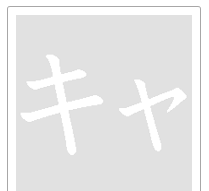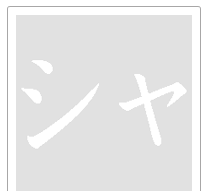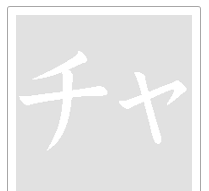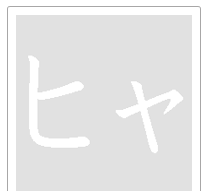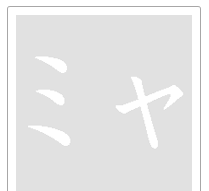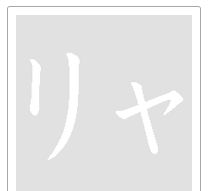Twisted sounds While you are now familiar with all the katakana characters, mora like
kya, kyu or kyo have not been covered. To pronounce the kya sound, for
instance, first say ki and then ya; now, say both sounds more quickly; kya is a contraction of ki and ya. By the same token,
kyu is a contraction of ki and yu, and kyo of ki and
yo. |
||||||||||||||||||||||||||||||||||||||
| キャ
キュ
キョ
kya kyu kyo
To produce this set of mora, combination of キ and a small-sized ヤ, ユ or ヨ is used, making キャ, キュ and キョ, respectively. If you use a computer, these characters are obtained by spelling kya, kyu and kyo.
When ギ is used instead of キ, making ギャ, ギュ and ギョ, they are then romanized as gya, gyu and gyo, respectively. Try reading the following words and compare with the recording:
Now, write the words above on your PC. |
|
|||||||||||||||||||||||||||||||||||||
| シャ
シュ
ショ
sha
shu sho
In the same manner, combinations of シ and ャ, ュ and ョ ( i.e. シャ, シュ and ショ ) represent the sya, syu and syo sounds. These sounds, however, are spelled sha, shu and sho in Hepburn-style romanization, because of the [sh] sound in English. Using a computer, either spelling will produce the same Japanese characters.
When you use ジ instead of シ, the characters ( ジャ, ジュ and ジョ ) represent zya, zyu and zyo, which are spelled ja, ju and jo in the Hepburn-style as this looks more familiar to English natives. Again, either spelling will get you the same Japanese characters on a computer. Now, try to read the following words and listen to the recording to compare:
Now, write the words above, on your PC. Your PC should support Japanese characters. |
|
|||||||||||||||||||||||||||||||||||||
|
By now, you should probably be able to guess what sounds チャ, チュ and チョ represent with ease. These are tya, tyu and tyo in the Nihon-style, or cha, chu and cho in the Hepburn-style. Again, either spelling will produce the same Japanese characters on a computer.
Now, try reading the following words and listen to the recording:
Practice the words above on your PC. Your PC should support Japanese characters. ヂ
is pronounced ji, which is generally written ジ,
so there is no point in using ヂ
to write the ji sound. Accordingly,
ヂャ,
ヂュ
and
ヂョ
are virtually never used. These sounds are written ジャ, ジュ
and ジョ,
respectively. (Should you need to get the characters ヂャ,
ヂュ
and
ヂョ on the computer for whatever reason, spell "dya", "dyu" and "dyo", respectively.)
|
|
|||||||||||||||||||||||||||||||||||||
|
Now,
it should not be hard to recognize what sounds
ニャ,
ニュ
and
ニョ represent. Try reading the following words and listen to the recording:
Try writing the words above on your PC. |
||||||||||||||||||||||||||||||||||||||
| ヒャ
ヒュ
ヒョ
hya hyu hyo
ヒ, ピ and ビ give the same effect as well when combined with a small-sized ヤ, ユ or ヨ. Hence:
Try reading the following words and listen to the recording:
Write
the words above, on your PC. |
|
|||||||||||||||||||||||||||||||||||||
|
ミャ
ミュ
ミョ
mya myu myo
Now you can tell what sounds ミャ, ミュ and ミョ stand for: mya, myu and myo, respectively.
Can you guess the names of the following places?
Now, write the words above, on your PC. |
|
|||||||||||||||||||||||||||||||||||||
|
リャ
リュ
リョ
rya ryu ryo
The last set in this series is リャ, リュ and リョ, standing for the rya, ryu and ryo sounds, respectively. If you find it difficult to pronounce these sounds, first say リ, and then ヤ (or ユ or ヨ). Then, try to say both more quickly, letting them get closer together.
Now, pronounce the following words and compare your pronunciation with the recording:
Practice
writing the three words above on your PC. |
|
|||||||||||||||||||||||||||||||||||||
 |
||||||||||||||||||||||||||||||||||||||
| Copyright © 2017 ICI (International Communication Institute),. All Rights Reserved. | ||||||||||||||||||||||||||||||||||||||


